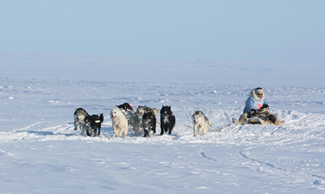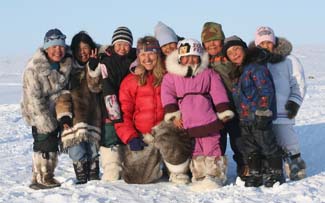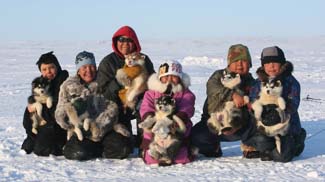In This Issue....
From the Editor: The Fan Hitch... EnhancedF.I.D.O.: Andrew Maher and Julia Landry
Fan Mail
In the News
Out on the Ice: Three Days with ISDs in North Greenland
Two Friends, Fourteen Dogs…One Quest!
The Nunavut Quest’s 10th Anniversary Run
BAS Vignette: Lampwick Harnesses
Sledge Dog Memorial Fund Update
CAAT’s 2008 Northern Schedule
The Chinook Project Returns to Kimmirut
Product Review Update: Double Driver Sled
IMHO: On Feral Cats and Inuit Sled Dogs
Navigating This
Site
Index of articles by subject
Index
of back issues by volume number
Search The
Fan Hitch
Articles
to download and print
Ordering
Ken MacRury's Thesis
Our
comprehensive list of resources
Talk
to The
Fan Hitch
The Fan
Hitch home page
ISDI
home page
Editor's/Publisher's Statement
Editor: Sue Hamilton
Webmaster: Mark Hamilton
The
Fan Hitch, Journal of the Inuit Sled
Dog, is published four times a year. It is
available at no cost online at:
https://thefanhitch.org.
The Fan Hitch welcomes your letters, stories, comments and suggestions. The editorial staff reserves the right to edit submissions used for publication.
Contents of The Fan Hitch are protected by international copyright laws. No photo, drawing or text may be reproduced in any form without written consent. Webmasters please note: written consent is necessary before linking this site to yours! Please forward requests to Sue Hamilton, 55 Town Line Rd., Harwinton, Connecticut 06791, USA or mail@thefanhitch.org.
This site is dedicated to the Inuit Dog as well as related Inuit culture and traditions. It is also home to The Fan Hitch, Journal of the Inuit Sled Dog.
The Fan Hitch welcomes your letters, stories, comments and suggestions. The editorial staff reserves the right to edit submissions used for publication.
Contents of The Fan Hitch are protected by international copyright laws. No photo, drawing or text may be reproduced in any form without written consent. Webmasters please note: written consent is necessary before linking this site to yours! Please forward requests to Sue Hamilton, 55 Town Line Rd., Harwinton, Connecticut 06791, USA or mail@thefanhitch.org.
This site is dedicated to the Inuit Dog as well as related Inuit culture and traditions. It is also home to The Fan Hitch, Journal of the Inuit Sled Dog.

Denise Malliki, of Repulse Bay is the first and only woman
to race in the Quest! She won in 2007 and became known in
the Baffin as "Queen of the Quest!" Photo: Lee Narraway
The Nunavut Quest’s 10th Anniversary Run
by Lee Narraway, White Lake, Ontario, Canada
by Lee Narraway, White Lake, Ontario, Canada
This year we travelled 500 miles (805 km) from Igloolik to Arctic Bay on the northern tip of Baffin Island. It was the 10th anniversary of the race and I have been timekeeper for seven of them.
We had 220 dogs in camp and about sixty people travelling as helpers and family. As you can see from the photo, I managed to collect quite a group of "helpers." They followed me everywhere!

Lee (red parka) and her entourage of "helpers".
Photo: Lee Narraway
This race was originally started in 1999, when Nunavut was declared a territory, to honour the role of the Inuit Sled Dog in the history of the Inuit. These dogs played such a significant part in the survival of the people up here, that they were also selected as the territorial animal (Imagine...it was not the polar bear!).
The race serves as a reunion for people in different communities. Every year a new start and finish community is chosen. Unlike our races down south, we have no media, no veterinarians, no trail markers...in fact, many years, there is no trail. The mushers never know their places or times until the final presentation ceremony when we arrive at our destination community. This is their choice. They say it would spoil the friendly camaraderie of the race. Considering that the prizes this year ranged from $15,000, $10,000, $5,000, $2500, to $1000 for all the rest of the finishers, this attitude is pretty significant.

Lee patiently waits to check in the teams.
Photo: Lee Narraway
We travel approximately fifty miles (80 km) per day then set up a camp and wait for the teams to arrive. I lean on a skidoo out of the camp at our makeshift finish line and write down the times of each team as they cross. Sounds easy, eh? But with the long waiting period for the slower teams, sometimes I am out there for ten hours or longer. And then there is the problem of reading the mushers' numbers through the blizzards. This year a blizzard started before we reached our first camp and we were stranded there the second day. Howling winds made it tricky to set up the tents and to keep them standing....and almost impossible to sleep.......24 hour daylight and constant noise!
I must admit, doing the timekeeper job is not may favourite activity, but I love being out on the land and sea ice with the Inuit. I am the only "Qalluniq"(white person) and now I pretty much blend in with the rest. That means I help set up tents and get teased by the women who think I should find myself an Inuk man so I would learn to speak their language quicker. I tease back saying that would not work because men preferred "koonnee, koonee" and would not care about talking! I sit on the ice with my friends and slice off chunks of frozen raw caribou and char and munch away on these treats. From time to time someone will come out to the skidoo where I am waiting and bring me hot palougaq (fried bread) and uyuq (seal or caribou stew) ...yumm. And on my birthday, at our daily morning meeting (and prayer to keep everyone safe on the land) they all sang Happy Birthday to me. I was so touched.
We had a church service on Sunday. The first hour was talking (in Inuktitut) and singing. Whenever I recognized a hymn, I sang along in English. The sun was shining and we were sheltered by the circle of tents and skidoos. It was peaceful and lovely. A man began to speak and then burst into tears. More people began crying and wailing. Then almost everyone was hugging, weeping and telling their stories. No one held back. The pain was so intense and surrounded us all. Being an empathetic weeper (surely I have inherited this from my Mom), I was bawling along with the rest. There was an official passer-of-the-toilet-paper, who went around to each person, giving them a strip of paper to blow their nose into. This went on for more than an hour. Later, someone told me it had been a healing service. The people were telling stories of their losses of loved ones through deaths, suicides, how much they missed them and of their early years living on the land before they were moved into communities. They also had talked about their experiences in the white man's residential schools. It was a moving experience to be there.

Photo: Lee Narraway
Results: 2008
Nunavut Quest, April 28 to May 7
1) 41 hr 10 min....Moses Oyukaluk (Arctic Bay)
2) 41 hr 15 min...Joey Aqqiaruq (Igloolik)
3) 41 hr 27 min ...Simon Qamanirq (Igloolik)
4 ) 41hr 36 min....John Quassa (Repulse Bay)
5) 42 hr 23 min....Peter Siakuluk (Hall Beach)
He has run in all 10 races.
6) 42hr 47 min....Jaipiti Palluq (Igloolik)
7) 44 hr 2 min....Esa Piungittuq (Clyde River)
8) 44 hr 10 min....Natalino Piugattuk (Igloolik)
9) 45 hr 9 min...Denise Malliki (Repulse Bay)
"The Queen of the Quest"; the only female to compete (first time in 2007)
10 ) 46 hr 57 min...Aimosie Sivgat (Clyde River)
11) 49 hr 18 min...Olayuk Barnabus (Arctic Bay)
12) 49 hr 42 min....Samuelie Ammaq (Igloolik)
13) 51 hr 1 min...Tom Nakitarvik (Arctic Bay)
14) 51 hr 10 min...Roland Taqtu (Arctic Bay)
15) 51 hr 12 min...Charlie Inuruaq (Pond Inlet)
16) 52 hr 29 min...Peter Kadlutsiaq (Hall Beach)
17) 54 hr 24 min...Lukie Airut (Igloolik)
18) 57 hr 35 min...Piugattuk Ettuk (Arctic Bay)
19) 58 hr 20 min...David Ikarialuk (Clyde River)
20) 78 hr 1 min...Daniel Inuaraq (Pond Inlet)
1) 41 hr 10 min....Moses Oyukaluk (Arctic Bay)
2) 41 hr 15 min...Joey Aqqiaruq (Igloolik)
3) 41 hr 27 min ...Simon Qamanirq (Igloolik)
4 ) 41hr 36 min....John Quassa (Repulse Bay)
5) 42 hr 23 min....Peter Siakuluk (Hall Beach)
He has run in all 10 races.
6) 42hr 47 min....Jaipiti Palluq (Igloolik)
7) 44 hr 2 min....Esa Piungittuq (Clyde River)
8) 44 hr 10 min....Natalino Piugattuk (Igloolik)
9) 45 hr 9 min...Denise Malliki (Repulse Bay)
"The Queen of the Quest"; the only female to compete (first time in 2007)
10 ) 46 hr 57 min...Aimosie Sivgat (Clyde River)
11) 49 hr 18 min...Olayuk Barnabus (Arctic Bay)
12) 49 hr 42 min....Samuelie Ammaq (Igloolik)
13) 51 hr 1 min...Tom Nakitarvik (Arctic Bay)
14) 51 hr 10 min...Roland Taqtu (Arctic Bay)
15) 51 hr 12 min...Charlie Inuruaq (Pond Inlet)
16) 52 hr 29 min...Peter Kadlutsiaq (Hall Beach)
17) 54 hr 24 min...Lukie Airut (Igloolik)
18) 57 hr 35 min...Piugattuk Ettuk (Arctic Bay)
19) 58 hr 20 min...David Ikarialuk (Clyde River)
20) 78 hr 1 min...Daniel Inuaraq (Pond Inlet)

Simon Qamanirq of Igluliq in a ground blizzard.
Photo: Lee Narraway
Lee Narraway is a professional photographer and freelance writer. Although her clients’ assignments send her all over the world, Lee has enjoyed a special affinity for the Canadian Arctic with which she is intimately familiar and where she is enormously respected in Nunavut’s communities. You can see more of Lee’s work on her website.
Editor’s note: The Nunavut Quest is the brainchild and the passion of Joeli Qamanirq and Niore Iqalukjuak of Arctic Bay who gave birth to the event to celebrate the 1999 creation of Nunavut Territory. In the past ten years, the event has grown, drawn younger participants, including (for the first time in 2007) women mushers, and has been credited with the creation of other such races now held in the Canadian North.